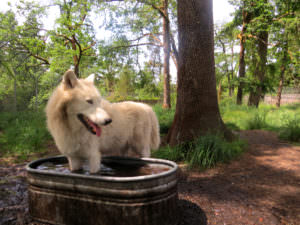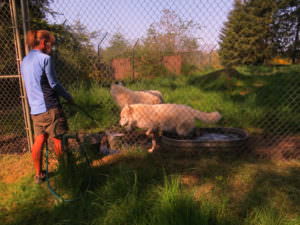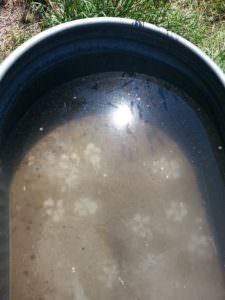Splish Splash
by Brennan Stoelb, Animal Care Specialist, Wolf Haven International
In a recent blog I mentioned that it has been hot here in western Washington. Read it here…… While on most hot days the wolves lay in the shade to keep cool, Wolf Haven also provides other means to beat the heat; splash tubs.
For the animals that enjoy wading in water, animal care places 45 gallon, galvanized tanks in their enclosure. Not every enclosure has a tank because, just like humans, not every wolf likes to get wet. The tubs are about a foot and a half tall, just enough to be below their stomachs. They’ll jump in the tub and begin pawing the water to make it splash. Lakota and Shadow are two residents who love their tubs.
As you might assume, all this playing in the tub can make for some messy water. Every week animal care scrubs the tubs and replaces the dirty water with clean. In some cases the water will be changed more frequently. Daily we top-off the tubs to replace any water that’s been splashed out. With sponges and diluted bleach in hand, we go about the task of cleaning. Not only does dirt and fur cloudy up the water, it’s not uncommon to see someone peeing in their tub. Nothing is better than filling a tub with cool, clean water, only to have them hop in and pee – to each his own, as they say. Sometimes during feeding, a piece of meat will fall the wrong way and land in the tub.
One day when I was feeding a treat to Lakota, a piece fell in the tub. Not to let a little water stand in his way, Lakota stuck his head in the water, over his eyes, and sort of “bobbed” for his treat. Unfortunately, he was unsuccessful. I threw him a replacement, which he ate, but he went back to the tub and pawed the surface of the water, ever hopeful that it may float to the surface.
It surprises some people to hear that wolves can swim. They have webbing between their toes to help them move more easily on snow and uneven surfaces. This webbing also helps when swimming. Wolves will cross streams while chasing prey but
photographers captured one young wolf in Canada swimming to catch a goose. Perhaps his “rubber ducky?”
On Lake Superior in northern Michigan there is an island called Isle Royale. Once connected by a predictable ice bridge in the winter, Isle Royale has become a subject of recent debate. Home to a 56 year study on moose and wolf interactions, the island’s wolves are in decline. According to the annual report, there are nine wolves on the island, two of which are female. Scientists are concluding that the decline is a result of inbreeding both in prey and predator, since no new genetics are regularly coming to the island. To get to the island, wolves would have to swim about 15 miles. In 1997, a wolf from Canada affectionately called, “The old grey guy,” crossed the ice bridge and became a successful breeder. The debate amongst scientists is whether humans should intervene by bringing new genes to the island or let nature take its course. For more information on Isle Royale visit www.isleroyalewolf.org.
So if the heat gets to you this summer, do what the wolves do – and take a dip!




very cool post-it 🙂 …… 🙂 keep on keepin on :)….
I bet it’s great entertainment to watch the wolves playing in the water.
Interesting debate re Isle Royale, and there is no easy answer. I am curious about the other species on the island that can’t swim or fly. Surely, they are facing the same issues. Under normal circumstances, no wolves means moose and deer populations would increase. However, they are in decline as well, so does this mean the entire island is on the verge of losing most of its native species?
All species self-regulate, so even if there were no wolves on the Island (or as they have seen in previous years when wolf numbers were low), prey populations may grow exponentially, but they will eventually reach carrying capacity (particularly in a closed environment like Isle Royale).Their numbers will drop as they succumb to things like starvation, pressures from inbreeding, disease, etc. If you go back and look at the population trends of the wolves and their prey on the Island, you will see that they rely on each other to keep their numbers in check and to keep their populations at a sustainable level. Pressures from inbreeding is another matter entirely but it takes many generations to see the negative impacts. Wendy Spencer, Director of Animal Care